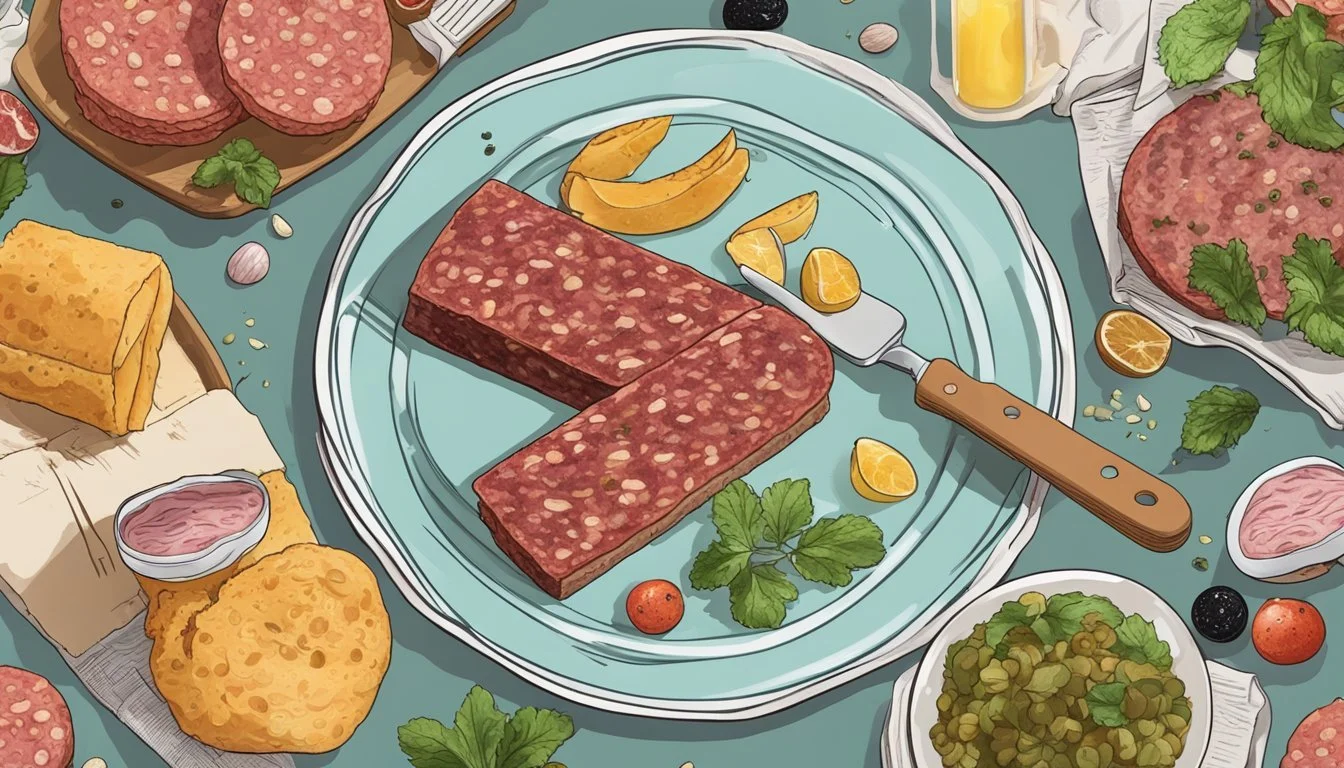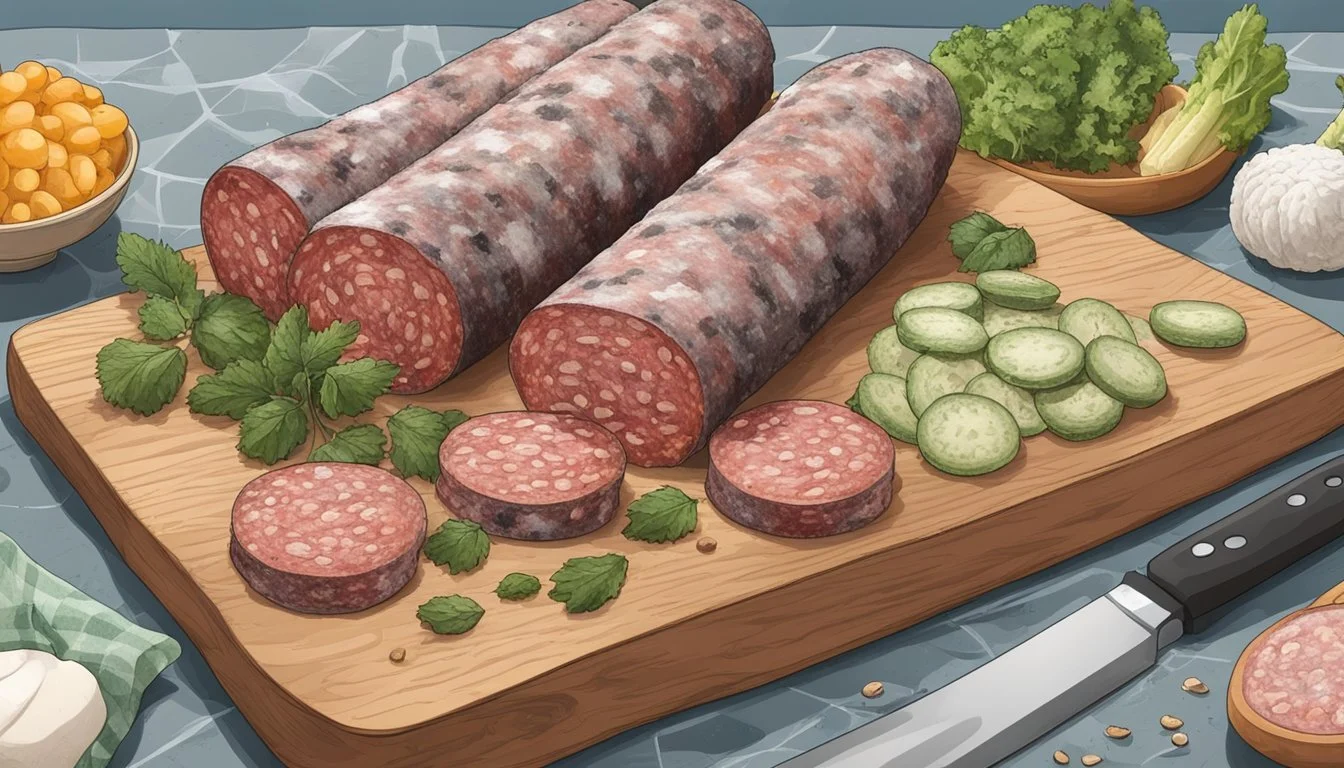Is it Safe to Eat Moldy Salami?
Understanding Health Risks and Safety Tips
For many, discovering mold on a favorite food can be alarming. When it comes to salami, the situation might not be as dire as it seems. The white mold on salami, known as Penicillium Nalgiovense, is purposefully introduced during the curing process to protect the meat and is completely safe to eat. This specific strain of mold plays an essential role in the fermentation of salami, ensuring it remains flavorful and free from harmful bacteria.
Despite the reassurance provided by the presence of this beneficial mold, it's important to recognize when mold growth indicates potential spoilage. While white mold is harmless, spotting black, green, or fuzzy mold on salami can be a sign that the meat has gone bad and should be discarded. Knowing the difference between these various types of mold can help prevent foodborne illnesses and ensure that your salami remains a safe and enjoyable part of your diet.
Understanding the nuances of mold on food, especially delicacies like salami, can enhance both the safety and enjoyment of your culinary experiences. Informed choices about which molds are safe and which are not can help you confidently navigate the complexities of food safety.
Understanding Mold
Mold is a type of fungus that thrives in warm, damp environments. It can appear on a variety of foods, and understanding its characteristics and effects can help determine its safety.
What Is Mold?
Mold is a microscopic fungus that grows in filaments and reproduces via spores. Spores are tiny and lightweight, allowing them to spread easily through air, water, and insects.
Penicillium, Aspergillus, and Cladosporium are three common genera of mold. They can appear in various colors, such as white, blue, green, and black.
Molds need moisture and organic matter to grow, making humid environments ideal for their proliferation.
Types of Molds in Foods
White Mold: Commonly found on salami and certain cheeses, white mold, like Penicillium nalgiovense, is typically safe and even beneficial. It prevents harmful bacteria growth and aids in the curing process.
Blue Mold: Often present in blue cheeses, blue mold (Penicillium roqueforti) is intentionally introduced and safe for consumption.
Green and Black Mold: These molds can grow on fruits, vegetables, nuts, and bread. They are usually seen as harmful and need to be discarded.
Mold Spore Transmission
Mold spores are ubiquitous in the environment. They can travel through air, attach to damp surfaces, and thrive.
Spores can spread through direct contact or through the movement of air and insects. High humidity and the presence of water facilitate mold growth, especially in kitchen settings where food is stored.
Common Mold-Prone Foods
Certain foods are more susceptible to mold growth due to their moisture content.
Cheese: Blue and white molds are common on cheese and can be safe if they are of edible varieties.
Bread: Mold grows rapidly on bread due to its moisture and carbohydrates.
Fruits and Vegetables: These foods, especially those with high water content, such as tomatoes and strawberries, are prone to mold.
Nuts and Legumes: Stored nuts and legumes can develop Aspergillus mold, which can produce harmful aflatoxins.
Sausage and Deli Meats: White mold on salami and other cured meats is usually safe to eat and a sign of proper curing.
Yogurt and Jams: High-protein and sugar-rich products like yogurt and jams can also develop mold if left too long.
Understanding the types of molds and their growth conditions is crucial for food safety. Identifying safe and harmful molds helps prevent foodborne illnesses and ensures the quality of consumable products.
Salami and Mold
Mold on salami is common and often considered safe due to beneficial mold strains like Penicillium nalgiovense. However, distinguishing between safe and unsafe mold types is crucial. Proper storage practices enhance salami's shelf life and prevent harmful mold growth.
Safety of Mold on Salami
White mold on salami, primarily caused by Penicillium nalgiovense, is intentionally cultivated. This mold protects the salami from harmful bacteria and provides a distinct flavor.
Penicillium nalgiovense is harmless and even beneficial, contributing to the curing process by maintaining moisture levels. When visible, this white mold indicates a well-cured, safe-to-consume salami. It's integral to produce high-quality, dry-cured country ham and hard salami.
Identifying Unsafe Mold on Salami
Not all mold on salami is safe. Green, black, or yellow mold can indicate harmful strains that may produce toxic substances like aflatoxin. These molds appear fuzzy or slimy and can pose health risks.
Unsafe mold should be carefully removed, and the surrounding area of the salami discarded. If the salami smells off or the mold's color is unusual, it's prudent to err on the side of caution and discard the product to avoid potential health hazards.
Proper Storage of Salami
Proper storage is essential to prevent unsafe mold growth. Salami should be stored in a cool, dry place, ideally in the refrigerator. Once opened, it should be wrapped in plastic wrap or butcher paper to maintain freshness.
Ensuring cleanliness and hygiene in storage areas minimizes contamination risks. Salami's shelf life can be extended significantly when stored correctly, contributing to both safety and flavor preservation.
Avoid storing salami in damp environments as moisture accelerates mold growth. Periodically check stored salami for any signs of spoilage and ensure it’s consumed within its recommended shelf life for optimal safety and quality.
Health Implications
Eating moldy salami can raise concerns due to potential health risks such as exposure to mycotoxins and possible allergic reactions. It is important to understand the specific dangers and how they might affect the body.
Mycotoxins and Health Risks
Mycotoxins are toxic compounds produced by certain molds. These can contaminate food, posing health risks. However, the white mold commonly seen on salami, Penicillium Nalgiovense, is usually safe and part of the curing process. This mold prevents harmful bacteria and other molds from growing.
Despite this, unintentional consumption of harmful molds like Alternaria can lead to mycotoxicosis. Symptoms include nausea, vomiting, and possibly liver damage. It's crucial to recognize the difference between safe, intentional molds used in food production and those that are harmful.
Allergic Reactions to Molds
Some individuals may experience allergic reactions to molds, even those considered safe, such as the white mold on salami. Symptoms of an allergic reaction include sneezing, itching, and respiratory issues. These reactions occur because the immune system identifies mold spores as harmful invaders and overreacts.
People sensitive to mold should exercise caution when consuming salami. If allergic reactions occur, it is advisable to seek medical advice. Knowing one's sensitivity to molds can help in making safer dietary choices.
By understanding these health implications, individuals can make better decisions about consuming moldy salami.
Safe Consumption Practices
When mold is present on food, understanding when it is safe to consume and how to handle the affected items is crucial. Mold can either be a natural part of food production, as with certain cheeses and cured meats, or an indicator of spoilage.
When Is It Safe to Eat Moldy Food?
Mold on hard cheese and salami is often safe to eat. For example, white mold on salami is intentionally grown to prevent harmful bacteria from forming. Similarly, blue and white molds on cheeses like Roquefort and Brie are part of the flavor profile.
Soft cheeses like cream cheese should be discarded if mold is present, as the mold may penetrate deeper than the surface. Firm fruits with moldy spots can be salvaged by cutting at least an inch around and below the moldy area.
Preventing Mold Contamination
Maintaining cleanliness in the kitchen and proper food storage can significantly reduce mold contamination. Store perishable foods in the refrigerator and ensure good ventilation to avoid excessive moisture. Use airtight containers for opened packages to limit exposure to air.
Regularly check and clean the refrigerator to prevent mold spores from spreading. Cross-contamination can be avoided by using separate utensils and cutting boards for different food types. Fresh produce should be consumed quickly and kept dry to minimize mold growth.
Mold Removal and Food Safety
For hard cheese, mold can be safely removed by cutting at least one inch around and below the affected area while keeping the knife away from the mold to prevent cross-contamination. With firm fruits, a similar technique can be used to safely remove the mold.
Soft fruits and cheeses, in contrast, should be thrown away if mold appears, as the mold can infiltrate deeply into the product. Ensuring proper food preservation methods, such as sealing leftover foods and maintaining cleanliness, are key practices to keep food safe from mold and bacteria. Proper food safety ensures enjoyable and healthy consumption.
Handled Foods and Mold Concerns
Mold can grow on various food products, affecting both safety and quality. This section addresses common concerns about mold in dairy products and fermented and cured meats.
Mold in Dairy Products
Certain dairy products, like brie, camembert, and blue cheese, incorporate mold intentionally during their production. This mold is safe to consume and contributes to the flavor and texture. For instance, gorgonzola and other blue cheeses contain Penicillium roqueforti, which creates their characteristic veins and strong taste.
Conversely, if mold appears on dairy products not typically associated with mold growth, such as cheddar, sour cream, or cream cheese, it may indicate spoilage. Mold can penetrate below the surface of these items, making it unsafe to simply scrape off the visible mold. Consumers should discard moldy cheddar, sour cream, and cream cheese to avoid potential health risks from bacteria growing alongside the mold.
Mold in Fermented and Cured Meats
Fermented and cured meats like salami and bacon often undergo processes where mold presence is part of manufacturing. Salami frequently has a white mold called Penicillium nalgiovense, which is deliberately introduced to prevent growth of harmful molds and bacteria. This mold layer is safe and can even be scrubbed off before consumption if desired.
However, if unexpected mold is found on cured meats or luncheon meats, it can be a sign of contamination. Unlike salami, these products should not generally have mold. The presence of mold on these meats warrants caution, as harmful bacteria might also be present. It is advised to discard such products to avoid potential health concerns.
Guidelines for Discarding Moldy Foods
Knowing which moldy foods to discard is crucial for maintaining food safety. Porous foods are particularly susceptible to deeper contamination. It’s important to follow specific guidelines for different types of food to avoid health risks.
Foods to Discard When Moldy
Soft cheeses, yogurt, and sour cream should be discarded if mold is present. Their high moisture content makes them susceptible to not only mold but also bacteria, which may spread beyond visible areas.
Cooked leftover meat and casseroles should also be discarded when moldy. These foods can harbor invisible bacteria along with the mold, adding to the risk.
Foods like bread, cakes, and other baked goods are porous, allowing mold to penetrate beyond the surface. Discard these if mold is visible.
Jams and jellies with mold may produce mycotoxins, which are harmful. These should be thrown away completely.
Mold Safety and Consumption Caution
Mold on food can sometimes produce harmful substances like mycotoxins. These toxins can pose health risks. If a food item has visible mold, it’s safest to err on the side of caution and discard it.
Certain foods, primarily those with higher moisture content like yogurt or sour cream, are more risky when moldy. They can harbor both visible and invisible bacteria.
Always inspect porous foods closely, as mold and its roots can burrow deep, escaping initial detection. Foods that are supposed to be mold-free but have visible mold should be completely discarded to avoid possible mycotoxin ingestion.
Maintaining food safety starts with identifying which items must be discarded at the first sign of mold. These precautions help reduce the risk of consuming dangerous substances.




